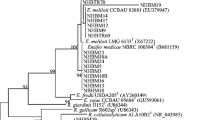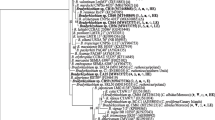Abstract
Nitrogen fixing rhizobia associated with the Medicago L. genus belong to two closely related species Sinorhizobium medicae and S. meliloti. To investigate the symbiotic requirements of different Medicago species for the two microsymbionts, 39 bacterial isolates from nodules of eleven Medicago species growing in their natural habitats in the Mediterranean basin plus six historical Australian commercial inocula were symbiotically characterized with Medicago hosts. The bacterial species allocation was first assigned on the basis of symbiotic proficiency with M. polymorpha. PCR primers specific for 16S rDNA were then designed to distinguish S. medicae and S. meliloti. PCR amplification results confirmed the species allocation acquired in the glasshouse. PCR fingerprints generated from ERIC, BOXA1R and nif-directed RPO1 primers revealed that the Mediterranean strains were genetically heterogenous. Moreover PCR fingerprints with ERIC and BOX primers showed that these repetitive DNA elements were specifically distributed and conserved in S. meliloti and S. medicae, clustering the strains into two divergent groups according to their species. Linking the Sinorhizobium species with the plant species of origin we have found that S. medicae was mostly associated with medics well adapted to moderately acid soils such as M. polymorpha, M. arabica and M. murex whereas S. meliloti was predominantly isolated from plants naturally growing on alkaline or neutral pH soils such as M. littoralis and M. tornata. Moreover in glasshouse experiments the S. medicae strains were able to induce well-developed nodules on M. murex whilst S. meliloti was not infective on this species. This feature provides a very distinguishing characteristic for S. medicae. Results from the symbiotic, genotypic and cultural characterization suggest that S. meliloti and S. medicae have adapted to different Medicago species according to the niches these medics usually occupy in their natural habitats.
Similar content being viewed by others
References
E G Biondi E Pilli E Giuntini M L Roumiantseva E E Andronov O P Onichtchouk O N Kurchak B V Simarov N I Dzyubenko A Mengoni M Bazzicalupo (2003) ArticleTitleGenetic relationship of Sinorhizobium meliloti and Sinorhizobium medicae strains isolated from Caucasian region FEMS Microbiol. Lett. 220 207–13 Occurrence Handle10.1016/S0378-1097(03)00098-3 Occurrence Handle1:CAS:528:DC%2BD3sXisV2mur4%3D Occurrence Handle12670682
M Bounejmate A D Robson (1992) ArticleTitleDifferential tolerance of genotypes of Medicago truncatula to low pH Aust. J. Agric. Res. 43 731–737
J Brockwell F W Hely (1966) ArticleTitleSymbiotic characteristics of Rhizobium meliloti: an appraisal of the systematic treatment of nodulation and nitrogen fixation interactions between host and rhizobia of diverse origins Aust. J. Agric. Res. 17 885–899 Occurrence Handle10.1071/AR9660885
G Brundu I Camarda M Caredda G Garau S Maltoni P Deiana (2004) ArticleTitleA contribution to the study of the distribution of Medicago-Sinorhizobium symbiosis in Sardinia (Italy) Agricoltura Mediterranea 134 33–48
B Brunel S Rome R Ziani J C Cleyet-Marel (1996) ArticleTitleComparison of nucleotide diversity and symbiotic properties of Rhizobium meliloti populations from annual Medicago species FEMS Microbiol. Ecol. 19 71–82 Occurrence Handle1:CAS:528:DyaK28Xhsleht74%3D
G K Bullard R J Roughley D J Pulsford (2005) ArticleTitleReview of fifty years of the legume inoculant industry and inoculant quality control in Australia: 1953–2003 Aust. J. Exp. Agric. 45 127–140 Occurrence Handle10.1071/EA03159
N Charman R A Ballard (2004) ArticleTitleBurr medic (Medicago polymorpha L.) selections for improved N2 fixation with naturalised soil rhizobia Soil Biol. Biochem. 36 1331–1337 Occurrence Handle10.1016/j.soilbio.2004.04.014 Occurrence Handle1:CAS:528:DC%2BD2cXls1Wmtrk%3D
F J Bruijn Particlede (1992) ArticleTitleUse of repetitive (repetitive extragenic palindromic and enterobacterial repetitive intergeneric consensus) sequences and the polymerase chain reaction to fingerprint the genomes of Rhizobium meliloti isolates and other soil bacteria Appl. Environ. Microbiol. 58 2180–2187 Occurrence Handle1637156
B D Eardly L A Materon N H Smith D A Johnson M D Rumbaugh R K Selander (1990) ArticleTitleGenetic structure of natural populations of the nitrogen-fixing bacterium Rhizobium meliloti Appl. Environ. Microbiol. 56 187–194 Occurrence Handle1:STN:280:DyaK3c7nvFWmtQ%3D%3D Occurrence Handle1689982
C M Francis D J Gillespie (1981) ArticleTitleEcology and distribution of subterranean clover and Medicago spp. in Sardinia Austr. Plant Intro. Rev. 13 15–25
F Galibert T M Finan S R Long A Puhler P Abola F Ampe et al. (2001) ArticleTitleThe composite genome of the legume symbiont Sinorhizobium meliloti Science 293 668–672 Occurrence Handle1:CAS:528:DC%2BD3MXls1KgtrY%3D Occurrence Handle11474104
D J Gillespie J A McComb (1991) ArticleTitleMorphology and distribution of species in the Medicago murex complex Can. J. Bot. 69 2655–2662
J G Howieson M A Ewing (1986) ArticleTitleAcid tolerance in the Rhizobium meliloti-Medicago symbiosis Aust. J. Agric. Res. 37 55–64 Occurrence Handle10.1071/AR9860055
J G Howieson M A Ewing (1989) ArticleTitleAnnual species of Medicago differ greatly in their ability to nodulate on acid soils Aust. J. Agric. Res. 40 843–850 Occurrence Handle10.1071/AR9890843
J G Howieson M A Ewing M F D’Antuono (1988) ArticleTitleSelection for acid tolerance in Rhizobium meliloti Plant Soil 105 179–188 Occurrence Handle1:CAS:528:DyaL1cXhs1CmtbY%3D
J G Howieson A Loi S J Carr (1995) ArticleTitleBiserrula pelecinus L. – a legume pasture species with potential for acid, duplex soils which is nodulated by a unique root-nodule bacteria Aust. J. Agric. Res. 46 997–1009 Occurrence Handle10.1071/AR9950997
J G Howieson B Nutt P Evans (2000) ArticleTitleEstimation of host-strain compatibility for symbiotic N-fixation between Rhizobium meliloti, several annual species of Medicago and Medicago sativa Plant Soil 219 49–55 Occurrence Handle10.1023/A:1004795617375 Occurrence Handle1:CAS:528:DC%2BD3cXjsVWlsb0%3D
J A G Irwin D L Lloyd K F Lowe (2001) ArticleTitleLucerne biology and genetic improvement – An analysis of past activities and future goals in Australia Aust. J. Agric. Res. 52 699–712 Occurrence Handle10.1071/AR00181
D C Jordan (1984) Family III. Rhizobiaceae Conn 1938, 321AL N R Krieg J G Holt (Eds) Bergey’s Manual of Systematic Bacteriology Williams & Wilkins London 234–242
G Laguerre S M Nour V Macheret J S Pascal Drouin N Amarger (2001) ArticleTitleClassification of rhizobia based on nodC and nifH gene analysis reveals a close phylogenetic relationship among Phaseolus vulgaris symbionts Microbiology 187 981–993
K A Lesins I Lesins (1979) Genus Medicago (Leguminosae): A Taxogenetic Study Kluwer Academic Publishers Dordrecht
S Niemann T Dammann-Kalinowski A Nagel A Puhler W Selbitschka (1999) ArticleTitleGenetic basis of enterobacterial repetitive intergenic consensus (ERIC)-PCR fingerprint pattern in Sinorhizobium meliloti and identification of S. meliloti employing PCR primers derived from an ERIC-PCR fragment Arch. Microbiol. 172 22–30 Occurrence Handle10.1007/s002030050735 Occurrence Handle1:CAS:528:DyaK1MXmsVyitb8%3D Occurrence Handle10398748
D W Puckridge R J French (1983) ArticleTitleThe annual legume pasture in cereal-lay farming systems of Southern Australia: a review Agric. Ecosyst. Environ. 9 229–267
A E Richardson L A Viccars J M Watson A H Gibson (1995) ArticleTitleDifferentiation of Rhizobium strains using the polymerase chain reaction with random and directed primers Soil Biol. Biochem. 27 515–524 Occurrence Handle10.1016/0038-0717(95)98626-Y Occurrence Handle1:CAS:528:DyaK2MXlt12rsbg%3D
A D Robson (1969) ArticleTitleSoil factors affecting the distributionof annual Medicago species J. Aust. Inst. Agric. Sci. 35 154–167 Occurrence Handle1:CAS:528:DyaE3cXlsVWjsw%3D%3D
S Rome B Brunel P Normand M Fernandez J C Cleyet-Marel (1996a) ArticleTitleEvidence that two genomic species of Rhizobium are associated with Medicago truncatula Arch. Microbiol. 165 285–288 Occurrence Handle10.1007/s002030050328 Occurrence Handle1:STN:280:DyaK283hsVKmuw%3D%3D
S Rome J C Cleyet-Marel L A Materon P Normand B Brunel (1997) ArticleTitleRapid identification of Medicago nodulating strains by using two oligonucleotide probes complementary to 16S rDNA sequences Can. J. Microbiol. 43 854–861 Occurrence Handle1:CAS:528:DyaK2sXmslCitbk%3D Occurrence Handle9336948 Occurrence Handle10.1139/m97-124
S Rome M P Fernandez B Brunel P Normand J C Cleyet-Marel (1996b) ArticleTitleSinorhizobium medicae sp nov., isolated from annual Medicago spp Int. J. Syst. Bacteriol. 46 972–980 Occurrence Handle1:CAS:528:DyaK28XmsFyjurc%3D Occurrence Handle10.1099/00207713-46-4-972
M Sanchez-Contreras X Lloret M Martin M Villacieros I Bonilla R Rivilla (2000) ArticleTitlePCR use of highly conserved DNA regions for identification of Sinorhizobium meliloti Appl. Environ. Microbiol. 66 3621–3623 Occurrence Handle10.1128/AEM.66.8.3621-3623.2000 Occurrence Handle1:CAS:528:DC%2BD3cXlsFartr0%3D Occurrence Handle10919829
J T Versalovic T Koeuth J R Lupski (1991) ArticleTitleDistribution of repetitive DNA sequences in eubacteria and application to fingerprinting bacterial genomes Nucleic Acids Res. 19 6823–6831 Occurrence Handle1:CAS:528:DyaK38XnslelsA%3D%3D Occurrence Handle1762913
J Versalovic M Schneider F J Bruijn Particlede J R Lupski (1994) ArticleTitleGenomic fingerprinting of bacteria using repetitive sequence-based polymerase chain reaction Meth. Cell. Mol. Biol. 5 25–40 Occurrence Handle1:CAS:528:DyaK2MXhtVOmsLc%3D
K Zribi R Mhamdi T Huguet M E Aouani (2004) ArticleTitleDistribution and genetic diversity of rhizobia nodulating natural populations of Medicago truncatula in Tunisian soils Soil Biol. Biochem. 6 903–908
Author information
Authors and Affiliations
Corresponding author
Rights and permissions
About this article
Cite this article
Garau, G., Reeve, W., Brau, L. et al. The Symbiotic Requirements of Different Medicago Spp. Suggest the Evolution of Sinorhizobium Meliloti and S. Medicae with Hosts Differentially Adapted to Soil pH. Plant Soil 276, 263–277 (2005). https://doi.org/10.1007/s11104-005-0374-0
Received:
Accepted:
Issue Date:
DOI: https://doi.org/10.1007/s11104-005-0374-0




